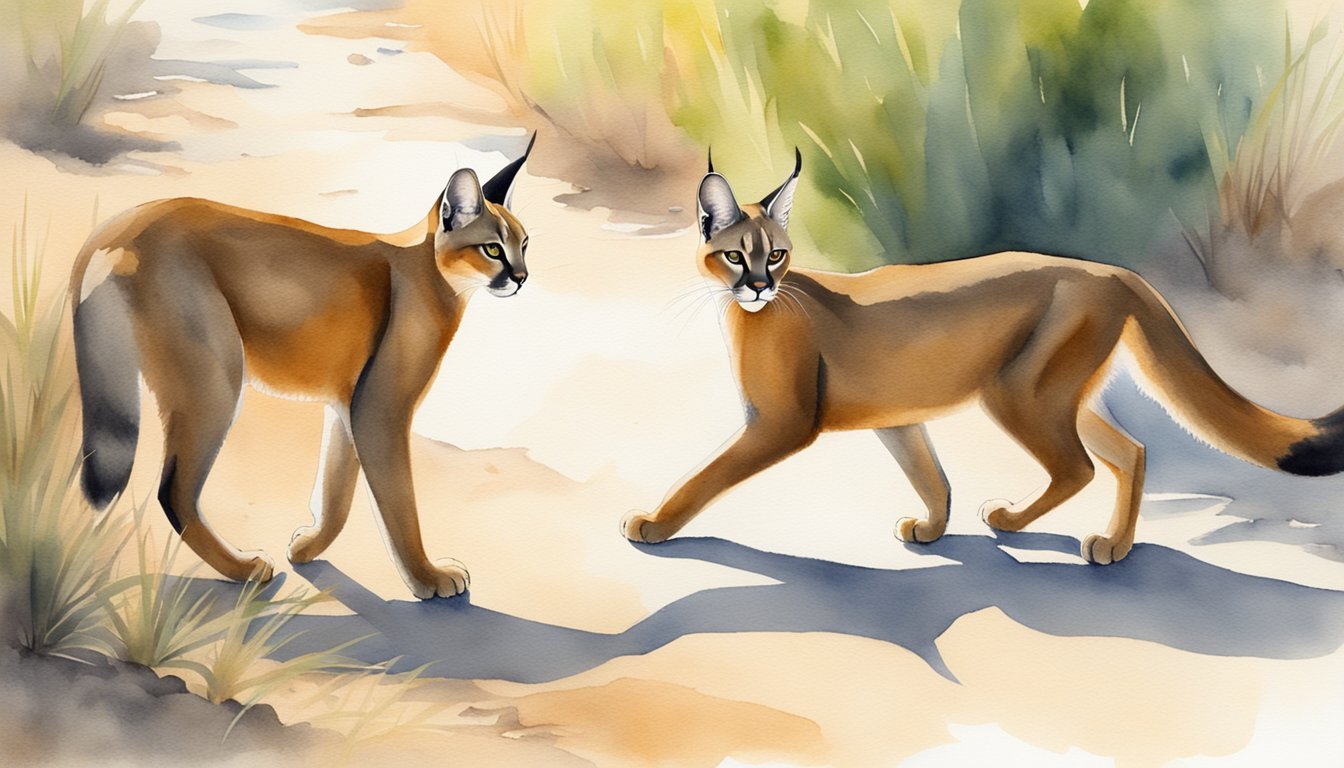Caracal Characteristics
The caracal, also known as Caracal caracal, displays distinct features and behaviors that are well adapted to a variety of habitats across Africa and Asia. This medium-sized wild cat is known for its agility, hunting prowess, and unique physical appearance.
Physical Attributes
Caracals are notable for their tufted ears, which stand erect on the tops of their heads. These black tufts are one of their most distinctive features. Adult caracals have a robust build with long legs, particularly their hind legs, which are well adapted for leaping. Their coat ranges in color from a tawny-gray to a reddish-brown, and sometimes entirely black melanistic animals may occur. The size and weight of a caracal can vary, with some reaching up to 50 cm (20 in) at the shoulder and weighing between 8-19 kg (18-42 lbs).
Diet and Hunting
Caracals are carnivorous predators that mainly prey on small mammals, birds, and rodents. Their diet often includes hares, squirrels, and even small antelopes, and they possess remarkable agility to take down larger prey like young gazelles. They are also capable of a powerful leap to catch birds mid-flight, demonstrating their exceptional hunting abilities.
Behavior and Lifestyle
These solitary and territorial wild cats are mostly nocturnal, engaging in hunting under the cover of night. They use various forms of communication including visual signals, growls, and scent marking with urine to interact with one another, particularly during mating season. Reproduction results in litters that typically range from one to six kittens, which the females take sole care of after birth.
Habitat and Distribution
Caracals inhabit a range of habitats including deserts, forests, and woodlands. Their adaptability has allowed them to thrive in various regions across sub-Saharan Africa, North Africa, Central and West Africa, and parts of Asia, including the Middle East, India, and Central Asia. Despite their extensive habitat range, each caracal maintains a distinct territory.
Conservation Status
According to the IUCN Red List, the caracal is currently listed as Least Concern. However, they are still threatened by habitat loss and conflict with humans. Effective conservation strategies are essential to ensure the species does not face a higher threat level in the future.
Human and Caracal Interactions

Interactions between humans and caracals are multifaceted, encompassing aspects ranging from livestock predation and pet ownership to cultural significance and conservation efforts. These interactions can lead to conflicts as well as opportunities for research and study.
Caracals and Livestock
In some regions, caracals are known to prey on livestock, which can put them at odds with farmers. They may hunt young wild boar and European hare, but in areas where these are scarce, caracals may hunt domestic animals, leading to economic losses for owners.
Caracal as Pets
Although wild by nature, caracals have been kept as pets in certain areas. Their care requires an understanding of their wild instincts and a commitment to providing for their complex environmental and dietary needs, which do not align well with a typical household pet lifestyle.
Cultural Significance
Historically, caracals have held significant roles in some cultures, particularly in Persia where they were used for sport in hunting games. They are featured in art and folklore, symbolizing qualities like agility and ferocity.
Conservation Efforts
With their conservation status being of least concern globally but vulnerable in certain areas, conservation efforts are crucial to ensure the species does not become threatened. Habitat protection and reducing human-wildlife conflict are key strategies employed by conservationists.
Encounters and Conflicts
Caracals may come into conflict with humans when they are spotted in populated areas. Due to their elusive nature, such encounters are not well-documented, but they can heighten the perceived threat of caracals to humans and strain conservation efforts.
Research and Study
The study of caracals contributes to the body of science around predators and their interactions with other species, including humans. Research efforts are aimed at understanding their behavior, ecology, and the dynamics of their interactions with the environment.

